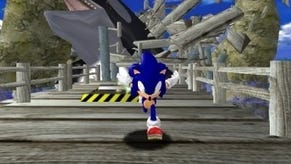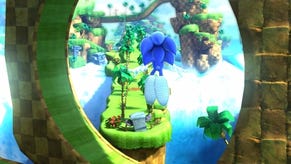Sonic Adventure
The blue blur returns! How's he been?
Swooosh!
The thing is, for such an understated success, Sonic relies on a very weak storyline. A big fat geezer called Dr. Robotnik spends his time snooping around the world searching for these things called Chaos Emeralds, of which there are seven. These emeralds hold the key to running the entire planet, obviously, and as either the blur of blue, Tails (the little orange Fox with two tails) or a few other characters, it's your job to save it again. Despite this weakness, I didn't feel put off playing the game at all. Differences between Sonic Adventure and its predecessor are numerous and expansive. For example, the game isn't just a long trawl through speedy horizontal levels; while it is still made up of Action fields and Boss fields, new Adventure fields help to take the focus of the game away from the anonymity and towards a more involving plot-line. Sonic Adventure's most immediate progression is the change from a 2D to a 3D setting. If you'd have told me this a year ago, I would have chuckled and muttered something about Mario 64 for animals, but the sceptic in me has been silenced once more. The speed of Sonic's movement doesn't lower the framerate across the board, although in a couple of areas I noticed it on occasion. Audibly, the game is surprisingly good. A blazing rock soundtrack seems a little misplaced at first, but it grows on you. Each character has his own theme tune, heard within the in-game cutscenes. The character voices are annoying, but only because they're so American. After a few days of listening to Sonic's drawl and Tails' rather pathetic squeaking, I suppose it's passable, but I would have been happy to live with a muted hedgehog. The lip sync doesn't do much to help its cause; complacent as it is at times. Speaking of sync, the control system seems like another good place to stop. Control of Sonic and his entourage via the gamepad is simple and effective. I've been increasingly more and more encouraged by the control Sega's 'pad gives me and none more so than by Sonic Adventure. While he flies across ravines and landscapes, I am in total control, never feeling let down by bad sampling or other things I sometimes wondered about in Tomb Raider and the like on the Playstation.
Sonic Continuum
The first 10 minutes of Sonic Adventure are odd and mildly confusing, especially so if you've played the previous versions! The player is shown a cutscene where Sonic squares off against a bullet-proof foe made of water. Then a brief Boss section where this puddle of pain must be subdued is included, before he slinks off down the drain (literally). Then the game whisks you off through the city to Sonic's pool-side retreat, where he observes young Tails ditching his biplane "in the drink", you take the reigns and shoot off down the beach and through the glades for a few minutes at about 200MPH in the game's first Action field. Upon finding the little chap, you can see that he's found a Chaos Emerald. Then after some drunken dialogue, he heads off to his place at the Mystic Caves, to where you must follow. Initial control of Sonic around Station Square, as I've already mentioned, is fluid and pleasingly easy to master. You enter the train station building and hear an announcement that a train is leaving. After rushing, well, Sonic does little else, toward the platform, you hop onto the train and depart. This is pretty much the tone of the proceedings from henceforth. A single player game though Sonic most certainly is, you won't tire of it. From the outset, there's a definite path that you take, via key locations, such as Station Square, Sonic's home town and the Mystic Caves, amongst others. Although the action is broken up by the frequent loading screens (most noticeably thanks to the overlying soundtrack cutting in and out accordingly), the game is easy to get into and hard to put down.
Fun Little Extras
One of the most creative aspects of the Dreamcast is the VMU. Sonic Adventure puts it to very good use. In the Station Square hotel building where Sonic starts off is based a Chao Garden. Inside are some eggs, which must be nurtured before hatching. Then the occupant, a cutesy little animal called a Chao can be placed on a gamepad-shaped box in the corner. From there it is uploaded to the VMU, where it can be grown and pampered, just like a Tamagotchi in fact. This can actually have some bearing on the course of the game, as you need to collect more Chao and grow them in the Chao Garden for use in battles and such. Those eggs that you find around the world can usually be transferred back to the Chao Garden by a teleport or uploaded to the VMU via a localised gamepad-shaped thing, just like the one found in the Chao Garden. Oh, and if you have a friend who has his own Chao-laden VMU, you can square both of them off by connecting the VMUs and selecting battle mode. That's not all; sub-games like Sonic Pinball punctuate the action. As with Soul Calibur (also on the Dreamcast), the game is packed to the brim with little extras and details that breathe pure excellence.
Conclusion
I once read that with the Star Trek films, a general rule of thumb is that the even numbered ones are worth watching and the odd numbered not. This is kind of reminiscent of the Sonic series now. The original was good but vastly too easy; the sequel doubled up on its predecessor, offering twice the fun. The third in the series disappointed on a grand scale as it simply tried too hard for the platform, but the fourth, Sonic Adventure, represents a return to fortune for Sega, just as the Dreamcast seems to have done. If you've ever enjoyed a platform game, this should appeal to you. Aside from a few lip synchronising problems and a slightly weak plot, the game reels you in and never casts you out. Much more than the Sunday afternoon stopgap that I had hoped for.
What The Scores Mean
- Out Now




